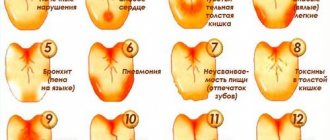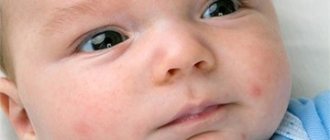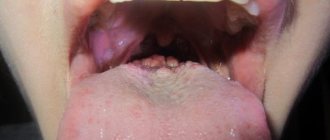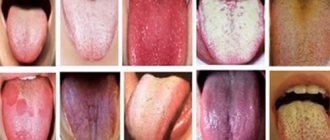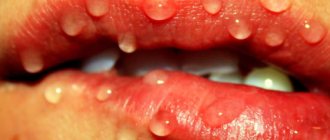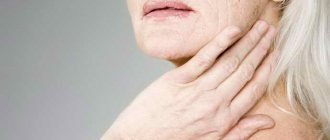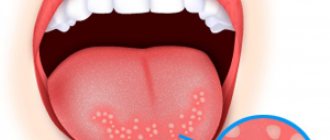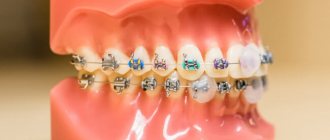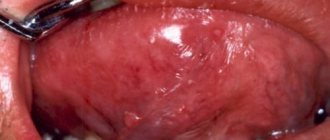Thrush on the tongue of a baby is a common disease.
In most cases, parents do not pay attention to this pathological condition. As a result, treatment begins late. And this is wrong, since candidiasis often becomes chronic.
Every adult should have an understanding of the signs of the disease, how it can be treated and what will happen if appropriate measures are not taken.
What it is
Thrush on the tongue of a newborn is a fungal disease. The main causative agent is Candida fungus. A favorable environment for infection to multiply is created by warmth, high humidity and the absence of oxygen.
Fungal microorganisms are present in small quantities on the skin and mucous membranes.
A good immune system prevents their development and reproduction, preventing the occurrence of a pathological process.
However, with weakened immunity, the body’s protective functions decrease. This leads to intensive growth of pathogenic bacteria and the development of fungal infection.
Since the baby’s immunity is not yet fully formed, the baby is susceptible to the negative effects of various fungi .
Candidiasis looks like cheesy plaques and is accompanied by painful sensations.
What is thrush in a child?
White plaque during the disease is located everywhere in the oral cavity:
- on the inner surface of the cheeks;
- on the gums;
- in the sky;
- on the tongue.
This is the so-called candidal stomatitis.
But the fungus affects not only these areas. Thrush can be seen on many sensitive areas of a child's skin - the armpits, folds in the groin, the skin around the anus. Such lesions are called candidal dermatitis.
The affected areas of the skin look like white dots, similar to wen. Diaper rash appears. A comfortable environment for fungal growth is created in diapers, where urine and feces remain for some time. And diapers come into contact with the baby’s bottom, contributing to the development of fungal inflammation.
The modern pharmaceutical industry offers parents a large selection of hygiene products for baby's skin care. These include wet wipes, lotions, special antiseptic powders, creams, and much more.
Thrush on the tongue refers to the oral type of candidiasis. Infants are mainly susceptible to it. This disease cannot be ignored. It appears as white cheesy grains on the tongue. If the disease is not treated, the grains gradually turn into a film that completely covers the child’s tongue. A feature of this type of candidiasis is the absence of odor.
Symptoms and manifestations of candidiasis in infants
The main sign of candidiasis is a white coating on the surface of the tongue. Over time, milk plaques spread to the gums, buccal mucosa and palate.
As the disease progresses, the child may experience symptoms such as:
- anxiety;
- tearfulness;
- refusing the breast or bottle.
This condition is explained by painful sensations when sucking. Over time, the spots affect the entire surface of the mucous membranes. The result is large, light-colored films or a coating that resembles a curd mass in appearance.
If you clean your tongue of plaque, you will see inflamed red spots under the curdled pieces. This sign indicates the development of thrush.
Preventive measures
To avoid having to think about how to remove thrush from a newborn’s tongue, it is better to follow preventive recommendations. Careful adherence to hygiene rules and mandatory sterilization of bottles and nipples will help prevent the occurrence of pathology. After feeding, the baby should be given a few tablespoons of boiled water. It will be able to remove food debris, which prevents the spread of pathogenic microflora. Other preventive measures include:
- Strengthening the immune system. This includes massage, walks in the fresh air and hardening.
- Prevention and treatment of diseases that cause candida activity.
- Limit contact with potential carriers of the disease.
- Rational and balanced nutrition, proper introduction of complementary foods.
- Strict diet for a nursing mother. Sweets, pickles and canned food are excluded from the diet.
- Maternal hygiene. It includes a daily shower, changing breast pads every 4 hours, and treating the nipples with a baking soda solution.
- Clothes for mother and baby should consist of natural fabrics.
Prevention of thrush in infants who constantly spit up is especially important. Food from the stomach enters the oral cavity, where the necessary conditions are created for the development of fungus. The baby needs to be put to the breast correctly, and after feeding he needs to be carried in a column.
Thrush is a disease that can be quickly cured if the mother follows all the specialist’s recommendations. Be sure to use preventive and hygiene measures.
Just yesterday, your beloved baby was cheerful and lively, sucking milk with pleasure, playing, smiling. And today he is capricious, refuses to take the breast or bottle, and cries. Look into the baby's mouth. Have you seen a strange whitish coating on your tongue? This is a sign of a fairly common disease in newborns - thrush. You shouldn’t be too afraid of this; with timely treatment, the plaque goes away quickly.
We wrote earlier about white plaque on the tongue of a newborn (see article), this is a normal natural phenomenon, but if white “plaques” similar to cottage cheese appear in the mouth, then you need to react in time, and now we will show in detail how to identify thrush and tell you about ways to treat it.
Factors in the development of pathology
Anyone can be a carrier of the infection. Other microorganisms can keep fungi from actively reproducing. But since the baby has a weakened immune system, the likelihood of infection increases significantly.
Experts identify many reasons under the influence of which thrush appears on the tongue.
The most common ones include:
- failure to comply with hygiene standards necessary for the maintenance of an infant;
- the period of teething, which can provoke the progression of the pathological condition;
- infection of the child during passage through the mother’s birth canal, if she was diagnosed with thrush at that time;
- the presence of a high concentration of sugar in food (this applies not only to infant formula, but also to liquids);
- antibiotic treatment for mother or baby;
- the presence of characteristic diseases that weaken the immune system;
- violation of the acid balance of the oral cavity.
Therefore, newborns should be under increased attention, especially before they reach 6 months.
Antecedent factors
The highest percentage of the likelihood of developing thrush in children on the tongue appears before six months, since the baby’s body is just beginning to form its own immune defense system, and immunity from breast milk weakens by this time. Therefore, thrush on the tongue of a six-month-old baby can occur at any time from the moment the first teeth begin to erupt or after a common cold.
The next high probability of candidiasis in an infant occurs in the period from eight to ten months of age, when the child himself begins to move, crawl, walk and, in the course of his knowledge of the world around him, “taste” all objects available to him.
Also, a high probability of developing candicomycosis is observed in children who were sent to a preschool educational institution at an early age. During the period of adaptation of the child to the new environment, there is a noticeable decrease in the body's immune defense system, which can provoke the development of thrush.
Therapeutic measures
Finding a cheesy coating in the mouth of a baby should not cause panic. In young children, removing thrush from the tongue is not difficult. The main thing is to adhere to the recommendations of your doctor and follow them until complete recovery.
Medication
In most cases, infants are treated with medications that include nystatin. Other medications may be needed. Everything depends on the course of the pathological process.
To prevent the rapid spread of bacteria, experts recommend using ointments and solutions of the antifungal group. The duration of therapy is on average ten days.
You need to smear your child’s tongue with a cotton swab several times a day.
At the same time, it is necessary to treat the entire oral mucosa .
Thrush can be relieved with medications such as diflazone or diflucan. They are injected with a syringe.
You can also purchase special powders of this medication for intramuscular injections. The drug is diluted with a small amount of water. The mixture is given from a spoon.
At the same time, the oral cavity must be treated with this product. A positive result is noticeable already on days 4–6 of use.
One of the most effective remedies for eliminating thrush in children is the Biovital-gel vitamin complex.
Folk remedies
However, there are situations when it is not possible to seek medical help in a timely manner. In this case, to relieve the baby’s unpleasant symptoms, you can undergo treatment at home.
Treatment with soda
One of the effective remedies for thrush is a soda solution. To prepare it, you need to add 10 g of soda to 200 ml of boiling water.
To carry out the procedure, you need to wrap a bandage around your finger. Then moisten it in the resulting composition and wipe the tongue, gums and palate.
It is important that the movements are smooth, without pressure. Otherwise, it can cause severe pain during the inflammatory process.
It is recommended to carry out soda therapy up to four times a day with an interval of three hours. The duration of the course is a week.
Honey in the treatment of thrush in a newborn
If the newborn does not have an allergic reaction, you can get rid of the disease using a honey solution. Honey has an antimicrobial effect and helps eliminate any pathological process of fungal origin.
To prepare the medicine, you need to mix a teaspoon of this product with two tablespoons of boiling water.
The treatment is carried out according to the same principle as in the case of using a soda solution.
Experts recommend treating the pacifier after each feeding using one of the methods described above.
Drug treatment
The first step in treating the disease is to eliminate the causes that cause the infection to develop. The diet of a nursing mother is completely adjusted. It includes more cereals, boiled vegetables and dairy products. Sweets, marinades, smoked foods, canned foods and possible allergens (citrus fruits, red berries and vegetables) are removed from the diet.
To avoid infection, mothers should treat nipples with baby soap before each feeding. You should not use brilliant green.
How to treat thrush on the tongue of a newborn? Treatment of the disease is carried out using local or systemic antifungal drugs. It can be combined with the prevention or treatment of concomitant diseases that contribute to candida activity. These include regurgitation and disruption of intestinal microflora.
Help cure the disease:
- Medicines and ointments of local significance (“Candide”, “Pimafucin”). The affected areas are treated 4 times a day. To do this, use cotton swabs or treat with a finger wrapped in gauze. There is no need to remove all the white plaque, because under the influence of the medicine, Candida colonies die on their own. An improvement in the baby's condition can be noticed after 3 days. On the 6th day, the symptoms stop and the child recovers.
- Antifungal drugs and ointments are prescribed by a specialist. They are involved in treatment if there is no improvement in the condition. They are most often taken orally in the form of a suspension or given as injections.
- Antipyretic and painkillers based on paracetamol and ibuprofen. These include "Efferalgan", "Panadol". Before offering the breast or bottle, apply lidocaine numbing gel to the affected areas.
Juices are excluded from the baby's diet. Fruit acids contained in drinks irritate the oral mucosa and cause pain.
Danger and complications
If a newborn is diagnosed with thrush on the tongue, then therapeutic procedures should be started immediately. At first glance, a harmless disease can lead to the development of unpleasant consequences if left untreated.
When the pathological process becomes severe, it can provoke a number of serious complications.
Among the most common, experts highlight the following:
- inflammatory processes affecting the oral mucosa, against which bleeding ulcerations are observed;
- secondary infection, the penetration of which into the body is facilitated by formed lesions;
- rapid spread of plaque over the surface of the mucous membranes;
- cracks on the lips and gums;
- severe pain while eating;
- increase in temperature indicators.
To protect your baby from such consequences, it is important to start treatment for candidiasis on time.
Principles of therapy
If you find thrush on the tongue of a month-old baby, you should not panic, as this pathology is easily treatable, even in babies. The main principle of successful therapy is the regularity and consistency of the procedures until the child fully recovers. It is very important, as soon as the baby gets sick, to visit a pediatrician to prescribe a more effective treatment regimen for the pathology. But, if this trouble happened on holidays or weekends, when all medical institutions are closed, then every mother should know how to properly cure thrush on the tongue of a newborn at home, or at least eliminate the unpleasant symptoms.
Application of soda
To effectively treat your baby’s oral cavity, it is recommended to prepare a soda solution by dissolving a teaspoon of baking soda in a glass of boiled water at room temperature. Then wrap your index finger with a wide bandage or a gauze napkin, moisten it in the prepared solution and gently wipe the entire oral cavity and tongue of the baby.
Very important! Do not make any effort to remove the whitish coating from the surface of the tongue, as this can injure the inflamed mucous surface and lead not only to bleeding, but also to an increased likelihood of pathogenic microbes entering the baby’s body.
Carry out soda procedures regularly at least 5 times a day, every 3 hours, for 2-3 days. If the child does not want to open his mouth himself, then it is recommended to lightly press his chin with the thumb of his free hand and hold it throughout the entire treatment procedure.
Honey treatment
If the child is not allergic to honey, then this ingredient can be used to eliminate the fungal infection. Honey is a natural antiseptic and, thanks to its antimicrobial properties, any fungal disease can be eliminated, especially since the baby will really enjoy the “sweet therapy”. Honey medicine is prepared by mixing one teaspoon of natural honey with two tablespoons of boiled water. The treatment procedure with the resulting solution should be carried out in the same way as with soda, at least 5 times a day.
After each feeding procedure, it is also recommended to treat the baby’s pacifier in one of the above solutions before giving it to the baby. And all toys, bottles and other objects that the baby can pull into his mouth must be subjected to heat treatment by boiling.
If proper treatment is carried out and if the baby’s oral cavity is treated regularly, the symptomatic signs of thrush should disappear within 3–4 days.
Probability of relapse
A disease such as thrush in infants tends to recur. To completely remove a pathogenic fungus from a child’s body, you need to contact an experienced specialist. He will identify the true cause of the disease and select adequate therapy.
Under no circumstances should you self-medicate. Even the use of traditional medicine must be agreed with a doctor.
Incorrect therapeutic tactics will only temporarily relieve the symptoms of the disease, but not eliminate the pathogen. In the future, re-development of the pathology may occur.
When should you expect thrush?
- The greatest likelihood of contracting this type of stomatitis persists in newborns up to 6 months, since the baby is just acquiring its own immunity, and the mother’s natural defense is no longer so strong.
- After six months, thrush in the mouth or tongue can appear completely unexpectedly in any toddler during teething or after a cold, when his immunity is significantly weakened.
- The next period of risk begins at 8-10 months, when the baby begins to independently move around the house - crawling, then walking - and tries out all the objects that he can reach.
- Often candidomycosis appears in young children who went to kindergarten very early. In this case, during adaptation, a decrease in immunity occurs, and the abundance of “foreign” microflora contributes to the appearance of stomatitis.
Prevention
Until the baby reaches six months of age, the risk of developing thrush remains high.
This is explained by the fact that the immune system of the child’s body is still completely at the stage of formation. During this period, it is best to provide the child with complete protection from fungal infections .
To do this, experts advise following some recommendations that will prevent the development of the disease:
- Before breastfeeding your baby, you must wash your hands with soap.
- After the child has eaten, it is advisable to give him boiled water at room temperature. This action will remove any remaining dairy product from the mouth. After burping, you also need to give the baby something to drink.
- When a newborn appears in the family, it is important to adhere to the rules of hygiene not only for the baby, but also for the parents, especially the mother.
If it was not possible to avoid the pathology, then after treatment it is important to follow a number of measures to prevent its re-development.
The essence of prevention is to regularly boil the baby's nipples, bottles and toys. When it is not possible to sterilize objects, you need to treat them with boiled water.
Causes of the disease
In newborns, thrush on the tongue can develop due to the following reasons:
- due to infection of the baby during natural childbirth when the baby passes through the mother’s birth canal infected with candida fungi;
- lack of compliance with hygiene standards by the mother, namely, failure to keep the mammary glands clean, lack of heat treatment of the baby’s nipple, bottle and toys;
- taking antibiotic drugs by the mother, or treating any diseases in the child with medications of the same spectrum of action;
- development of hypovitaminosis;
- anemia;
- a disorder of the digestive tract in a child that becomes chronic;
- weakening of the body’s immune defense system during periods of teething, the development of dysbacteriosis, or during acute respiratory infections;
- Feeding a child with sweet foods and sweetened water also creates all the conditions for intensive reproduction of Candida fungi.
To prevent re-infection of a child, it is recommended to accurately identify the true cause of the development of the pathology.
What will the doctor prescribe?
If treatment with soda or honey solution does not help get rid of stomatitis on the tongue and mouth of the baby, then you need to contact your pediatrician. He will assess the baby’s health condition and prescribe treatment with modern antifungal drugs. Usually these are medications that contain fluconazole (Diflazon, Diflucan). They are given to the baby using a special syringe or spoon. They also need to lubricate the lesions in the mouth.
Thrush on the tongue, gums and inner cheeks in newborns can be treated with topical gels and ointments (Nystatin, Miconazole). They are carefully applied with a cotton swab or finger to the affected area in the baby’s mouth.
Causes of the disease
- Infection of the child during passage through the birth canal, if the mother was diagnosed with thrush during pregnancy.
- Failure of the mother and maternity hospital staff to comply with basic hygiene standards.
- Treatment of infants or nursing mothers with antibiotics.
- Weakened immunity during the period of teething, during or after a cold, with dysbacteriosis.
- Dirty toys and items for feeding the baby.
- Excessively sweet water and baby food, which create excellent conditions for the proliferation of candida fungi.
It is very important to identify the specific cause of the disease in order to avoid re-infection of the baby in the future.
Tips for mom
- Thoroughly wash and disinfect your baby's nipples and pacifiers.
- During the period of illness, boil all children's toys that the little one usually tries.
- If you are breastfeeding, maintain nipple hygiene - rinse them with a soda solution immediately before and immediately after each feeding.
- Be sure to undergo treatment for thrush with your baby - this is necessary so as not to infect the baby again.
With the strictest hygiene rules and proper treatment, thrush can be cured in 3-5 days. However, if your doctor recommended you a specific treatment regimen using medications, then you must adhere to it, because apparent rapid success in treatment does not always mean complete elimination of thrush.

